Latest Gear Live Videos
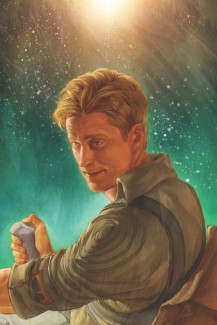 Comedian and comic book enthusiast Patton Oswalt lends his writing talents to Joss Whedon‘s Firefly universe with the upcoming one-shot Float-Out.
Comedian and comic book enthusiast Patton Oswalt lends his writing talents to Joss Whedon‘s Firefly universe with the upcoming one-shot Float-Out.
The comic, which is set to hit stores on June 2, picks up where Serenity left off. Chronicling the late Wash’s friends, the story marks a new chapter in the Firefly ‘verse. Oswalt talks about continuing this world in comic book form and shares a little about how he felt with Whedon’s ending:
“Post-Serenity’ a bunch of Wash’s friends who we haven’t met on the show, they’re basically buying a new ship and christening it… It’s called a ‘float-out’ when you christen a ship. As they’re christening a new ship, they’re telling stories about Wash, and we’re basically seeing what could be the start of a new adventure… I had always been kind of bothered by Wash’s death.”
A fan of the television series, Oswalt didn’t have to do heavy research to take on the project and was quite inspired to continue the story: “It was very frustrating to see the show get canceled when a world was starting to come together. I just wish Fox had given it some more time, I guess.”
Patric Reynolds provides the interior art and Buffy the Vampire Slayer Season 8 artist Jo Chen lends her skills to the cover (seen above).
Read More  | Splash Page
| Splash Page
Advertisement
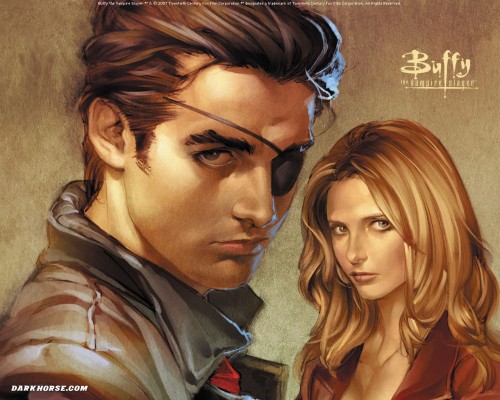
Buffy the Vampire Slayer gets a second chance! Well, sort of.
Not to be confused at all with the rumored Buffy reboot by the rapacious Kuzuis, it has been reported that Joss Whedon‘s Buffy the Vampire Slayer Season Eight comic books will be translated into a motion-comic web series.
No word yet as to whether or not original cast members from the television series will appear, but casting director Jeff Shuter is already looking for voice actors to fill familiar and new roles. If you sound like Sarah Michelle Gellar or D.B. Woodside, this gig may be for you—check out the complete cast list after the jump (they’re looking for non-union).
While this good news comes after Dollhouse‘s cancellation, I have my doubts.
Click to continue reading Buffy Season 8 Comic Book Gets Web Series
Read More  | Sci Fi Wire
| Sci Fi Wire
Preview: Dr. Horrible Prequel Comic

Posted by Robin Paulson Categories: Movies, Television, Dark Horse Comics,
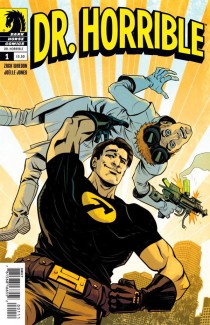 If you are anything like myself, you can’t wait for the Dr. Horrible sequel. Thankfully for folks like us, the Whedon crew adheres to our insatiable craving for all things Whedon-related, offering us a comic book chronicling the origin of Dr. Horrible’s feud with Captain Hammer.
If you are anything like myself, you can’t wait for the Dr. Horrible sequel. Thankfully for folks like us, the Whedon crew adheres to our insatiable craving for all things Whedon-related, offering us a comic book chronicling the origin of Dr. Horrible’s feud with Captain Hammer.
Zack Whedon teamed up with Joelle Jones for the one-shot, which is published by Dark Horse.
“It’s a prequel to the web series, and you get to see his first of many embarrassing encounters with Captain Hammer. But the web series is really an origin story too, so this is a little prelude to that,” explains Whedon, who co-wrote Dr. Horrible’s Sing-Along Blog with brothers Joss and Jed, as well as Jed’s new wife, Maurissa Tancharoen.
Check out the first six pages of the 24-page book after the jump, then head over to your comic book shop when the full issue hits stores on November 18th.
Click to continue reading Preview: Dr. Horrible Prequel Comic
Read More  | MTV
| MTV
Osamu Tezuka & Astro Boy

Posted by Tom Mason Categories: Editorials, Dark Horse Comics, IDW Publishing,
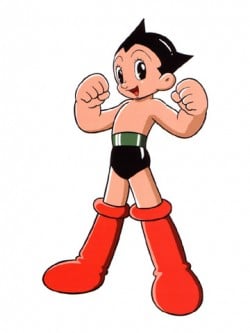 It’s here! After a long and seemingly painful production process, the new Astro Boy CGI feature is in theaters. You can find clips and cool stuff over on the official Astro Boy website. If you want to find out about all things Astro Boy, my favorite go-to place is Astro Boy World. They’re dedicated to “everything Astro Boy, the works of Osamu Tezuka, and other related anime & manga.” They’ve got video, news, factoids, lots of great graphics, and more.
It’s here! After a long and seemingly painful production process, the new Astro Boy CGI feature is in theaters. You can find clips and cool stuff over on the official Astro Boy website. If you want to find out about all things Astro Boy, my favorite go-to place is Astro Boy World. They’re dedicated to “everything Astro Boy, the works of Osamu Tezuka, and other related anime & manga.” They’ve got video, news, factoids, lots of great graphics, and more.
Astro Boy was created by Osamu Tezuka (the “God of Manga” and “The Walt Disney of Japan”) and debuted back in the early 1950s under the title Tetsuwan Atomu (The Mighty Atom). It later became an animated TV series in Japan in 1963. Since then, Astro Boy’s made a lot of comic book appearances here in the US, as recently as right now. Let’s take a look.
IDW: The gang over at IDW released two brand-new Astro Boy comic book series this year. One was a 4-part prequel to the Astro Boy movie and the other was an adaptation of the movie. You can probably still grab individual copies. Better still, they’ve already collected both of them in trade paperbacks that came out last month: Astro Boy: Movie Prequel and Astro Boy: Movie Adaptation.
Click to continue reading Osamu Tezuka & Astro Boy
Read More  | Astroboy Movie Official Site
| Astroboy Movie Official Site
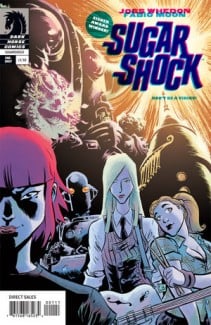 Originally published on the MySpace for Dark Horse Presents and later printed in MySpace Dark Horse Presents Vol. 1, Joss Whedon‘s Sugarshock is getting its one-shot, which hits comic book stores today.
Originally published on the MySpace for Dark Horse Presents and later printed in MySpace Dark Horse Presents Vol. 1, Joss Whedon‘s Sugarshock is getting its one-shot, which hits comic book stores today.
With a team like Joss Whedon (even if he does only read one comic) and Fabio Moon, it’s no wonder that the comic received the Eisner Award for Best Web Comic.
For $3.50, not only will you get the complete comic but an additional 14 pages of Moon’s process, with exclusive character designs, page layouts, and promos. What a deal, eh?
The story follows a very unlikely-matched rock band (i.e. the vocalist loathes Vikings, their bass player is a robot) set to participate in an intergalactic battle of the bands—an epic one, at that. Complete with Whedon quirks and quips as well as Moon’s playfully-appropriate artwork, Sugarshock is a must have—get it at your comic book store today!
Read More  | Dark Horse via Fabio Moon's Blog
| Dark Horse via Fabio Moon's Blog
Joss Whedon Only Has Eyes For The Walking Dead

Posted by Robin Paulson Categories: Interviews, Dark Horse Comics, Image Comics,
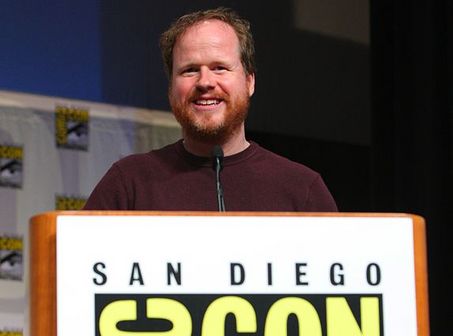
The lovable and very talented comic book geek-turned-television genius known as Joss Whedon has his hands so full with his latest show Dollhouse that he has only enough time to read one comic book series: The Walking Dead.
“That is the only comic I still read—literally. [I] paced myself because it was deep into the trades by then and I only let myself buy one trade a week, for a few weeks before I broke down because it was my favorite soap opera.”
Then again, who can resist a never-ending zombie apocalyptic story? I sure can’t.
So what does the series writer, Robert Kirkman have to say about having Whedon as a fan?
Click to continue reading Joss Whedon Only Has Eyes For The Walking Dead
Read More  | Geek Chic Daily
| Geek Chic Daily
Beasts of Burden #1: Evan Dorkin and Jill Thompson

Posted by Tom Mason Categories: Reviews, Dark Horse Comics,

Evan Dorkin is one of my favorite comic book creators. If he didn’t exist, the industry would have had to invent him. In a different era, he’d be a Renaissance Man for all his mad skills: writer, artist, cartoonist, blogger. His work has appeared in comic books, magazines, and on TV.
Now he’s at it again, this time with a four-issue mini-series he wrote and artist Jill Thompson (Sandman; Scary Godmother) painted - Beasts of Burden. It’s the story of the animals of picturesque Burden Hill who discover that there’s a supernatural element to their town they must stop. Without giving too much away, they are soon enlisted by a mysterious organization to fight an even greater evil.
Click to continue reading Beasts of Burden #1: Evan Dorkin and Jill Thompson
Steve Perry: Aliens, Predators and Men In Black

Posted by Tom Mason Categories: Editorials, Dark Horse Comics,
 Not too long ago, I was hired by a big time TV producer to ghostwrite a book for him. He had a screenplay that had been sent around and remained unsold and he wanted to try working backwards—convert the screenplay into a book, sell the book, get the book optioned and then sell the screenplay. Stranger things have happened, and he had enough contacts and name-value to give it a strong shot.
Not too long ago, I was hired by a big time TV producer to ghostwrite a book for him. He had a screenplay that had been sent around and remained unsold and he wanted to try working backwards—convert the screenplay into a book, sell the book, get the book optioned and then sell the screenplay. Stranger things have happened, and he had enough contacts and name-value to give it a strong shot.
I read the screenplay and we met for lunch at one of those nearly trendy places where you’ll likely see Bronson Pinchot eating an egg-white omelet and Tori Spelling ordering half of a flour tortilla. The intended audience for the book was to be Young Adult. We discussed tone and he was very clear—somewhere between Holes and Men In Black. I’d seen the whole Holes movie (and read the book), and I’d seen both of the Men In Black movies. (Today’s MIB trivia:I had also been the editor of the original Men In Black comics back in the stone age of comics and still keep in touch with MIB creator Lowell Cunningham.)
After the meeting, I went to a used bookstore as quickly as possible—except that they don’t exist anymore. So I went to Amazon and ordered a copy of the Men In Black novelization. I wanted to see how someone else had done the job with a similar property. I liked what I read and was impressed by how many little details the author had added while keeping the tone of the movie. He had also done an excellent job of capturing the personalities of J and K, which is no easy task. That author was Steve Perry, and I studied his approach the way others might Stephanie Meyer or a certain Rowling. Without realizing it, he was helping me follow in his footsteps.
Click to continue reading Steve Perry: Aliens, Predators and Men In Black
Read More  | Steve Bissette's Blog
| Steve Bissette's Blog
Comic Book School With Denny O’Neil? Cool!

Posted by Tom Mason Categories: Editorials, Dark Horse Comics, Marvel Comics,
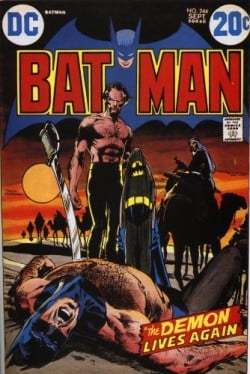 Denny O’Neil probably needs no introduction—he’s been an editor at both Marvel and DC and written many memorable and award-winning stories. He also wrote some of the best Batman stories ever (and it certainly didn’t hurt that a great number of them were illustrated by Neal Adams and Dick Giordano).
Denny O’Neil probably needs no introduction—he’s been an editor at both Marvel and DC and written many memorable and award-winning stories. He also wrote some of the best Batman stories ever (and it certainly didn’t hurt that a great number of them were illustrated by Neal Adams and Dick Giordano).
Denny knows more about writing comics than pretty much anyone in the business. He even wrote a book about it called The DC Comics Guide to Writing Comics.
Coming up at the end of this month—September 30 in fact—Denny’s going to be schooling a new generation of Dennyites. If you’d like to learn at the feet of a master of the form, that opportunity awaits you. Denny’s teaching a 10-week course at New York University’s School Of Professional & Continuing Studies, right there in New York City.
Click to continue reading Comic Book School With Denny O’Neil? Cool!
Read More  | NYU via Comic Book Resources
| NYU via Comic Book Resources
The Secret to Publishing Your Comic With Dark Horse

Posted by Kris Madden Categories: Editorials, Reviews, Dark Horse Comics,
“How do I get my great comic book idea published?” I’m glad you asked because Dark Horse is giving away the answer. No need to pickup a thick copy of “Writer’s Market 2009” to find out what DH is looking for from their creative talent. Senior editor, Randy Stradley, offers specific advice on breaking into the comic book industry. A goldmine of information to aid up-and-coming artists, Stradley offers details on new talent turn-around times and necessities for artist portfolios. A great resource for unpublished and up-and-coming comic books artists.
For More on Randy Stradley:
- A candid interview on his history with Dark Horse and what his plans for the future are at Digital City
- More tips on getting published in a Horsepower post.
- His process as senior editor and work with Dark Horse in CBR’s interview with Randy from February 2009,
For more on submitting work to Dark Horse, here is Dark Horse’s submission guidelines and sample script for artists.
Closed-Captioning for the Hearing Impaired per VideoJug:
How can an artist submit his work to you?
We have an open-submission policy. The people can send us stuff through the mail anytime. It tends to pile up for a while. We get a chance to look through it and we’ll whittle the pile down to nothing. It then builds up again. Here at the shows, people sign up ahead of time and it’s generally first-come, first-serve. For years we’ve tried to figure out a way to triage the line so that we tell the people who are ready, yes, get in line. For the people who aren’t, you’re not ready yet. You don’t need to show your work to an editor. It seems like, in recent years, that showing your work to the editor has become the “in” thing that you do. It’s just what you do. They don’t even know why they’re showing their work to an editor because I’m not an artist. I can’t really tell them how to draw better, or what techniques they should use. My job is to find people who can be given an assignment and be expected to pull it off.
What is the ideal artist portfolio?
The ideal artist portfolio is probably five to ten pages of consecutive story telling. Something that starts with a quiet scene and moves to an action scene. It includes everyday people in street clothes, buildings, cars, furniture, the stuff that the readers see every day. I always tell the artists being able to draw all the mundane stuff well is the most important part of seducing your readers into believing what they are looking at. So then when the monsters show up and the superheroes show up they are ready to except things. You have lured them in with this sort of real world that they can believe in, so they suspend their disbelief and the fantastic stuff goes down easy.
Do you prefer reviewing original or photocopies?
I am happy to look at copies, as long as they are good copies. I don’t need to see the full size originals. Yeah, it’s not a big deal.
What is the best advice for an artist submission?
Try before you show your portfolio, try to get a realistic assessment of your skill level and you do that by showing your work to somebody other than your family and friends who are all going to say, “Oh yeah, that’s great.” They’re not really going to be honest with you. So if you can find another comic artist to show your work to or strangers sometime or a teacher or something like that. Find out if you’re ready to be showing your work to try and get a professional job. Then when you do show your work, treat it like it’s a job interview. Be serious about it, come prepared. Don’t come with a bunch of excuses like well I didn’t have time to finish these pages, well yeah because COMICON only happens once a year so it totally took you by surprise didn’t it? Those things don’t fly. I want to see you show up as if you were doing a job interview.
Is having contact information on my work important?
It should be on everything that they leave with me. I’ve had it happen in the past where somebody’s given me great samples and I get back to the office and I realise they don’t have their name, phone number, email address or anything on the pages. Therefore, I have no way to know who that person is and no way to contact them. I’ve had great samples in the past for somebody who didn’t get a job because I didn’t know who they were.
Do you try to match the artist’s work you see to the stories you already have?
No, but I’m greedy. I think about the books I’m editing and what I have coming up and I think, “Oh, this guy would be good for that,” and “Oh yeah, I need an artist for this story”. Theoretically, I’m here being the eyes for all of the artists or all of the editors at Dark Horse, but I always think of myself first.
Do you look for a specific style of work?
You know for main stream comics, personally I edit a lot of Star Wars books. So I am looking for something like an artist who can handle likenesses, who can handle all the details of the hardware and everything but it can also be stylized and we have room for that. But generally if somebody is not drawing sort of, at least quasi realistically, probably their best bet is to either write their own story or attach themselves with a writer. And come up with a story that suits their style. And I am not saying find a Star Wars story that suits their style, but find you know, the kind of story they want to tell. That is how Dark Horse got started was with artists and writers who had stories of their own that they wanted to tell. We did not have any established characters when we started. So we could not say, oh write me this kind of story or draw this. We went with what they had created. The thing that separated Dark Horse at the beginning was that we allowed them to regain control of their own creations. Whereas if they had brought those creations to other companies, they would have had to sign away the rights to them.
Should I submit fully inked or colored artwork?
I would rather see just the pencils, or if they are going to show me ink work, have photocopies of the pencils, because not every artist is their own best inker. In fact, most of them aren’t, and with the way scanning technology has improved in recent years, we actually scan a lot of books directly from the pencils, and are able to reproduce them. In the old days when we had to photograph things, you just couldn’t do that. If it wasn’t dark enough, you needed to have the books inked. But nowadays, I only have one inker and I have got all the other books that are inter-shot directly from the pencils.
What happens if you like my artwork?
That’s when the challenge starts because if I say “you’re hired”, you have a month or forty days to turn around a 22 page story. Some are going to drop dead in terror, because they’re excited about it, at the time they think that’s what they wanted to do, but when it comes right down to it, drawing comics is a lot of work. And, I’ve had a number of occasions where somebody new has drawn one issue and that’s it. They decided “I can’t draw comics any more - it’s to much work.” And you really have to want to do it, especially we’ve had a lot of people who do movie story boards and they work in the entertainment industry and they’re in love with the idea of doing comics. So they do one issue and they are like, “No. I get paid a lot more to do story boards, I’ll stick with that.”
Does being a comic book artist pay well?
Paid rates are all over the board now. There are some people who make pretty good money. I had one agent telling me that, “Hey we’ve got artists who they’ll pencil, ink, letter and color an entire issue for $2500”. So you break that down, that’s a little over a hundred dollars a page for a lot of work. We try to pay better than that. But things aren’t as good as they were in the early nineties during the boom time, when there were artists literally making fortunes, because so many books were being sold and they were making so much money. But comics don’t sell that well anymore.
Advertisement
© Gear Live Media, LLC. 2007 – User-posted content, unless source is quoted, is licensed under a Creative Commons Public Domain License. Gear Live graphics, logos, designs, page headers, button icons, videos, articles, blogs, forums, scripts and other service names are the trademarks of Gear Live Inc.










